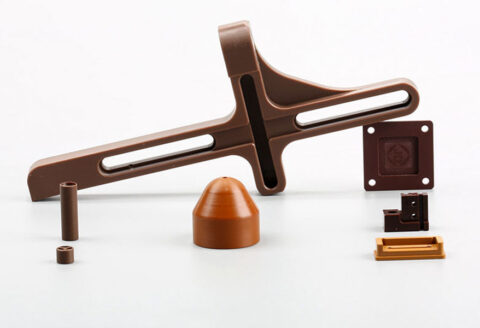Dongguan plastic mold mold opening plastic molds are mainly classified; according to different molding methods, plastic processing mold types corresponding to different process requirements can be divided. Dongguan plastic mold opening molds mainly include injection molding molds, extrusion molding molds, and blister molding molds. High-expansion polystyrene molding molds, etc.
1. Plastic injection (plastic) mold
It is mainly a molding mold that is most commonly used in the production of thermoplastic products. The corresponding processing equipment for plastic injection molds is a plastic injection molding machine. The plastic is first heated and melted in the heating cylinder at the bottom of the injection machine, and then melted in the screw of the injection machine. Or driven by the plunger, it enters the mold cavity through the nozzle of the injection machine and the pouring system of the mold, the plastic is cooled and hardened to form, and the product is demolded. Its structure is usually composed of molding parts, pouring system, guide parts, push-out mechanism, temperature control system, exhaust system, support parts and other parts. Manufacturing materials usually use plastic mold steel modules, and the commonly used materials are mainly carbon structural steel, carbon tool steel, alloy tool steel, high-speed steel, etc. The injection molding processing method is usually only suitable for the production of thermoplastic products. The plastic products produced by the injection molding process are very wide. From daily necessities to various complex machinery, electrical appliances, and transportation parts, they are all molded by injection molds. It is the most widely used processing method in the production of plastic products.
2. Plastic compression mould
It includes two structural mold types: compression molding and injection molding. They are a type of molds mainly used to form thermosetting plastics, and their corresponding equipment is a pressure forming machine. According to the characteristics of the plastic, the compression molding method heats the mold to the molding temperature (generally 103°—108°), then puts the measured compression powder into the mold cavity and the feeding chamber, and closes the mold. The plastic is under high heat and high pressure. It is a softened viscous flow, solidified and shaped into the desired product shape after a certain period of time. The difference between injection molding and compression molding is that there is a separate feeding chamber. The mold is closed before molding. The plastic is preheated in the feeding chamber and is in a viscous flow state. It is adjusted and extruded into the mold cavity under pressure to harden and form. Dongguan plastic molds are also used to mold some special thermoplastics, such as hard-to-melt thermoplastics (such as polyfluoroethylene) blanks (cold molding), resin lenses with high optical performance, and slightly foamed nitric acid. Cellulose car steering wheel, etc. The compression mold is mainly composed of a cavity, a feeding cavity, a guiding mechanism, an ejecting part, a heating system, etc. Injection molds are widely used for packaging electrical components. The material used in the manufacture of compression moulds is basically the same as that of injection moulds.
3. Plastic extrusion mould
A type of mold used to mold and produce continuous-shaped plastic products, also called extrusion molding heads, is widely used in the processing of pipes, rods, monofilaments, plates, films, wire and cable coatings, profiled materials, etc. The corresponding production equipment is a plastic extruder. The principle is that the solid plastic is melted and plasticized under the conditions of heating and the screw of the extruder to rotate and pressurize, and the cross-section is the same as the shape of the die through a specific shape of the die. Continuous plastic products. Its manufacturing materials mainly include carbon structural steel, alloy tools, etc. Some extrusion dies will also be inlaid with wear-resistant materials such as diamond on the parts that need to be wear-resistant. The extrusion process is usually only suitable for the production of thermoplastic products, and its structure is obviously different from that of the plastic injection mold and the compression mold.


